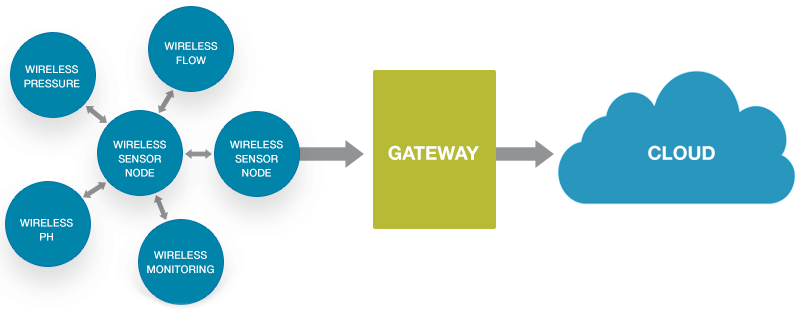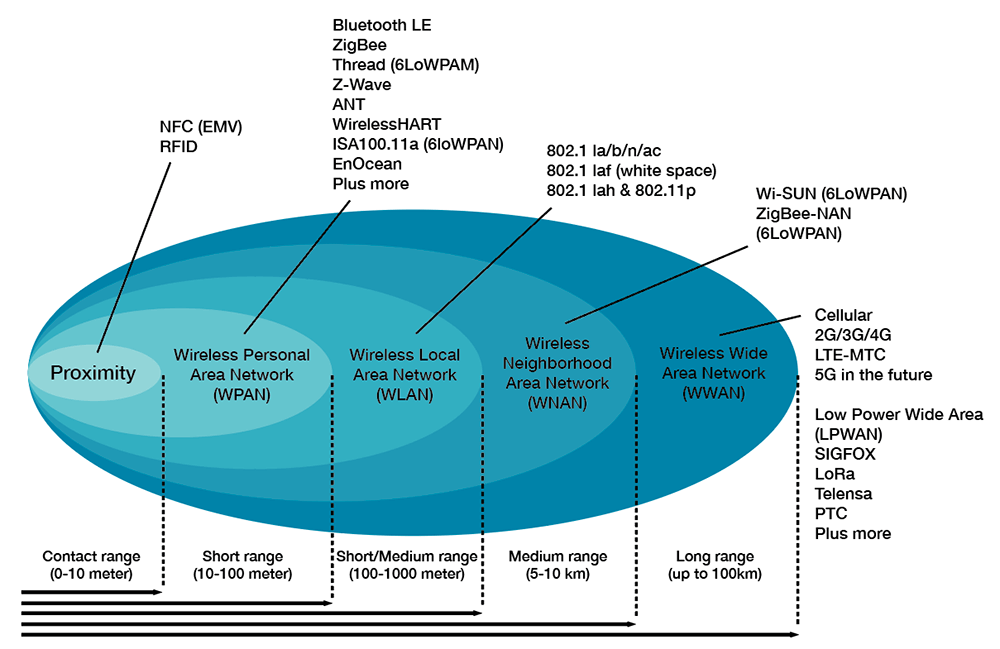Development kits provide easy access to the IoT
Getting connected has never been easier, thanks to a wide range of development kits and evaluation modules targeting the IoT.
The Internet of Things could perhaps be better described as a meta-network, within which not all of the billions of ‘things’ will be directly connected to the internet. As the IoT develops it is becoming clear that it will follow a more traditional hierarchy formed of local (open or closed) networks of ‘things’ (or nodes) comprising multiple technologies, which in turn are connected through a common platform with full internet access; the gateway. This highlights another significant sea change in the existing infrastructure; the way in which these networks will contribute to the whole. Increasingly this will be through cloud connectivity and in this respect the IoT and cloud computing have become interdependent. The combination of nodes, gateways and cloud connectivity provides a flexible definition of the IoT that can be applied in almost any application, giving substance to an otherwise figurative concept.

Figure 1. The Hierarchy of Internet of Things - Image: ©Premier Farnell Ltd
Worker Bees
Positioned on the edge of local networks, nodes will perform various tasks in the IoT but are likely to be classified as either sensors or actuators (or both). Data gathering is often cited as part of any IoT use-case, as it is often an intrinsic part of IoT-enabled value propositions such as increased automation or predicative maintenance. The value of data at a micro scale, particularly when used in macro-level analysis, is now very apparent.
Almost any parameter or physical property can be measured using advanced sensors. Environmental monitoring can provide valuable insights, and temperature and humidity are two conditions that are frequently included in IoT applications. The HDC1080EVM is a Plug & Play USB module designed for evaluating the HDC1080 relative humidity and temperature sensor from Texas Instruments, controlled through TI’s Sensing Solutions GUI.
The 18 STEVAL-STLK01V1 from STMicroelectronics is a development platform to support its SensorTile range of embeddable sensors. At just 13.5mm on each side, the tile in the kit integrates inertial sensors with a barometric pressure and a MEMS microphone. The firmware running on the host MCU supports data logging to an SD card as well as streaming over USB.
More specific applications for sensors in the IoT include healthcare and the MAXREFDES100# reference board provides the perfect platform for evaluating medical and fitness sensors from Maxim Integrated. Along with motion and skin temperature measurement, it supports electrocardiography and electromyography, as well as photo plethysmography measurements such as pulse oximetry and heart rate detection.
Many IoT nodes may require user input and one of the most versatile technologies available in this field is capacitive touch sensing. The CY8CKIT-145-40XX is a development kit for evaluating the capacitive touch technology developed by Cypress Semiconductor. Based on the PSoC 4000S, the kit includes two capacitive boards featuring both buttons and sliders, implementing self and mutual capacitive sensing.
Intelligent nodes may use other forms of detection, such as image recognition. The AMG883EK is an evaluation kit for the Panasonic Grid Eye IR sensor. Based on MEMS technology, the 8x8 pixel sensor can detect thermal presence and temperature, as well as determining the direction of movement.
Getting connected
IoT nodes will, by definition, be connected in some way; for small devices like sensors, wireless connectivity is emerging as the predominant solution. The CC2650STK is an evaluation kit in the form of a sensor tag with 10 sensors and multiple forms of wireless communications built in. The TI MCU at the heart of the tag supports wireless protocols designed for the 2.4GHz ISM range, including Bluetooth, 6LowPAN and ZigBee, which are all well positioned for IoT applications.
Developing with Bluetooth is made simpler through the availability of starter kits like the SLWSTK6020A from Silicon Labs, based on the company’s EFR32 Blue Gecko wireless SoCs. The kit also integrates humidity and temperature sensors. Similarly, the LAUNCHXL-CC2640R2F is part of TI’s LaunchPad range of development kits, providing easy access to Bluetooth Low Energy technology.
In the same range of development kits, the LAUNCHXL-CC1350EU is a Simplelink evaluation kit for applications that use both Bluetooth and Sub-1GHz wireless communications, while the LAUNCHXL-CC2650 goes even further to combine Bluetooth with ZigBee and 6LowPAN.
For nodes that require even more connectivity, the B-L475E-IOT01A1 development kit from STMicro integrates Bluetooth Low Energy, Sub-1GHz and NFC with Wi-Fi connectivity and supports direct connection to cloud services (see below for more on cloud services in the IoT). It also includes two omnidirectional microphones and a humidity/temperature sensor, as well as a 3-axis magnetometer, 3D accelerometer and gyroscope sensors, and a time-of-flight/gesture-detection sensor.
As a well-established technology, Wi-Fi will feature strongly in the IoT. For developers looking to evaluate possible solutions, the CC3200-LAUNCHXL is TI’s LaunchPad kit dedicated to Wi-Fi connectivity, while the RN2483-I/RM101 is a transceiver module targeting the burgeoning LoRA standard; a long range, low power solution for connecting IoT nodes over greater distances.

Figure 2. Wireless protocol options - Image: ©Premier Farnell Ltd
Powering IoT nodes
At the heart of any node will be a small, low power but highly integrated MCU. The STM32 Nucleo family from STMicro is well positioned for the IoT. It includes devices targeting both sensing and actuation applications and is supported by a range of development kits. One of the most prevalent architectures in MCUs for the IoT is, of course, the ARM Cortex-M and of these the Cortex-M4F offers many attractive features, including floating point capability. The MAX32625MBED# development board from Maxim Integrated highlights these features, particularly when developing wearable solutions.
Many IoT nodes are likely to be deployed in remote locations, with the intention of operating for many years from a single battery. This means power management is crucially important, the STEVAL-LDO1V1 is an evaluation board for four high performance LDOs from STMicro, providing a convenient way of assessing the right solution for any given application.
For nodes operating from rechargeable batteries, the MAX77650EVKIT# offers a simple way of evaluating the many features of the MAX77650 ultra low power PMIC from Maxim Integrated, including its buck-boost regulation, linear regulation and smart battery charging.
Gateways
While some nodes will be enabled to connect directly to (and be accessed by) the internet, many are likely to operate through a centralised gateway. Almost like a local server, the gateway will have more in common with traditional internet technology than most IoT nodes, as such it is likely to run a high-level operating system such as Linux, which offers support for all of the internet protocols used in the IoT and beyond.
A single gateway will be able to coordinate with many hundreds or even thousands of nodes, using all of the wireless connectivity protocols mentioned above (and perhaps more), as well as wired connectivity if necessary. The gateway will provide a lot of the security needed to protect the nodes and the data they generate, as well as keeping unwanted visitors out of the local network.
Consequently, gateways will tend to employ application processors as opposed to just an MCU. However, some devices will actually include both, such as the NXP i.MX 7Solo family which integrates an ARM Cortex-A7 core and an ARM Cortex-M4. These devices are known as heterogeneous multicore processors and the i.MX 7Solo is featured in the WaRP7 development board, which includes a daughter card that supports the development of wearable devices. Other single-board computers, like the BeagleBone Black Wireless and the Raspberry Pi , also provide the perfect platform for developing a gateway.
Into the Cloud
While nodes will operate locally, through gateways their data will most likely be passed to services running in the cloud. Cloud connectivity is now an essential part of the IoT, where many of the compute-intensive processing will reside.
Connecting to the cloud can be achieved through a proprietary solution but it is increasingly common to use a provider’s platform such as Microsoft’s Azure, Amazon’s AWS or IBM’s Watson IoT Platform.
The Pi3 IBM IoT Learn Kit includes a Raspberry Pi 3 Model B, Sense HAT and HAT enclosure, as well as an official Raspberry Pi power supply. It has been designed to connect to IBM’s Watson IoT Platform. The Things Network brings all aspects of the IoT together into a single kit using LoRA WAN technology, through an open network. By using this kit, the user becomes part of that open network, forming a virtual cloud platform. For developers looking to really leverage the power of cloud services, the BCM4343W IoT Starter Kit has been designed with cloud connectivity in mind and it comes with an SDK that provides direct access to both Amazon Web Services (AWS) and IBM Watson IoT Platform. For nodes that are intended to connect directly to cloud services, the OM13086UL Cloud Connectivity Kit could be the ideal place to start. It includes APIs to enable the kit to start working with cloud services with minimal software development, using Wi-Fi to directly connect the node to the cloud. Based on the LPC43S6x MCU from NXP it offers secure device provisioning and management.
Targeting the Industrial IoT through wired (Ethernet) connectivity, the DM990004 from Microchip is based on a PIC32MZ EF which comes pre-programmed with the firmware needed to connect to the AWS IoT service.
Conclusion
The IoT can be thought of as a virtual platform comprising multiple technologies, providing an opportunity to create new business models and value proposition. It combines new ways of meeting existing demands in all vertical sectors, with the potential to totally reinvent some of them. It also supports an unprecedented level of creativity that will feed ingenuity and innovation.
The fundamental building blocks of the IoT are nodes, gateways and cloud connectivity. Access to a wide range of development kits and evaluation modules is enabling manufacturers to explore this new global platform, which some see as the next industrial revolution.
Development kits provide easy access to the IoT. Date published: 22nd September 2017 by Farnell element14